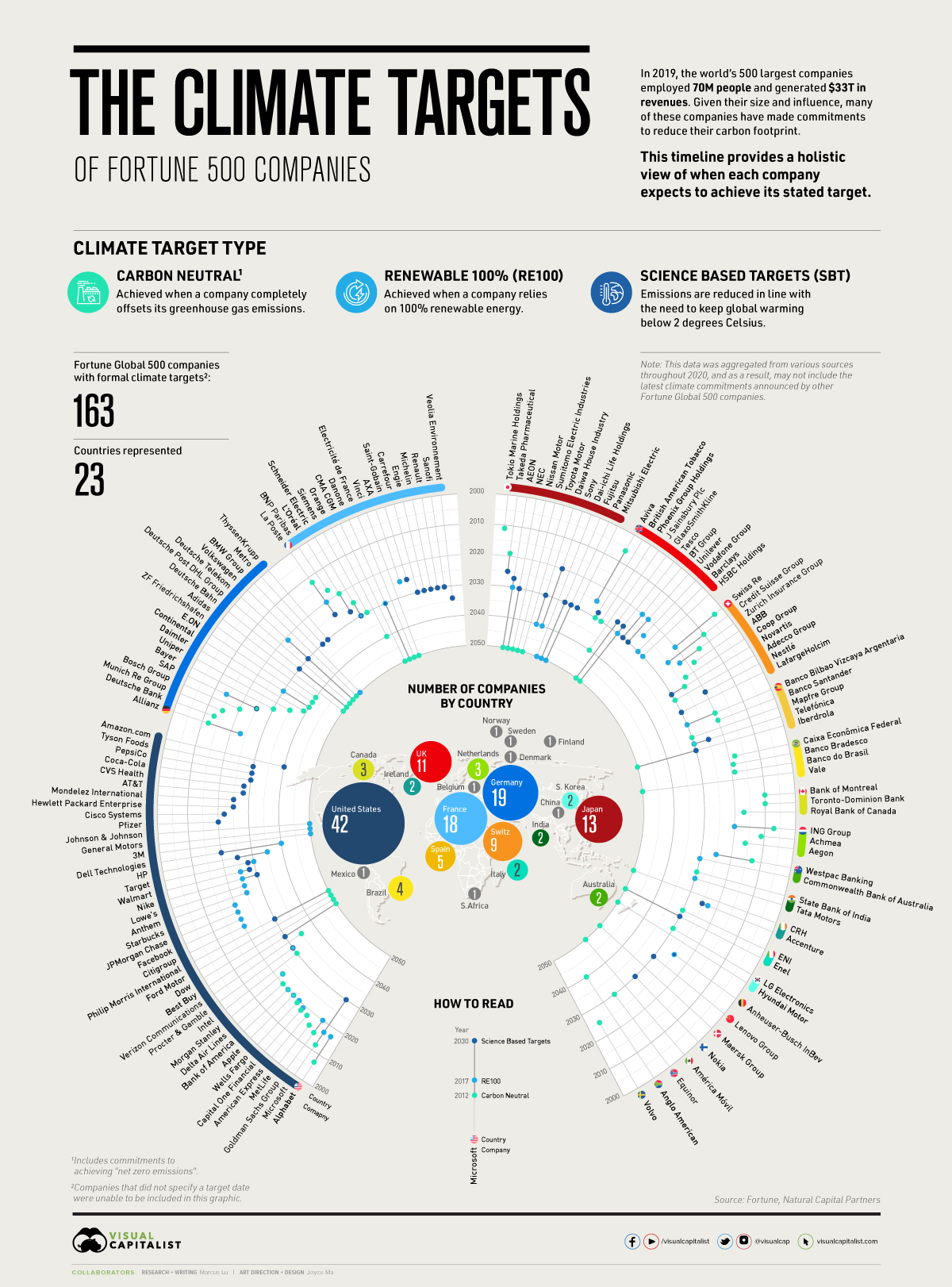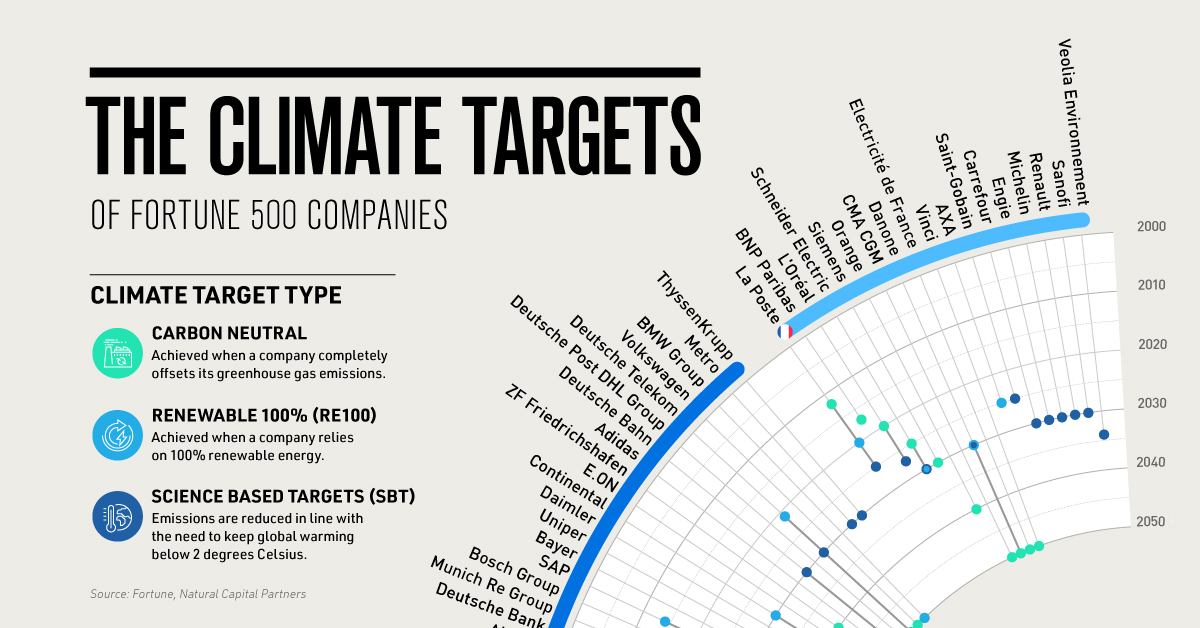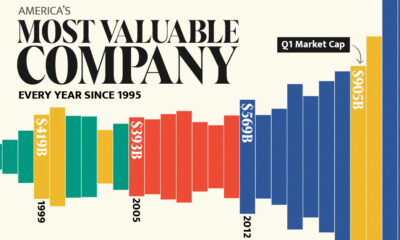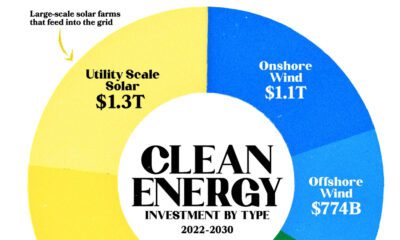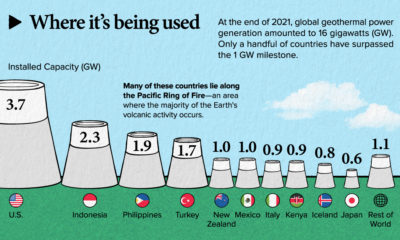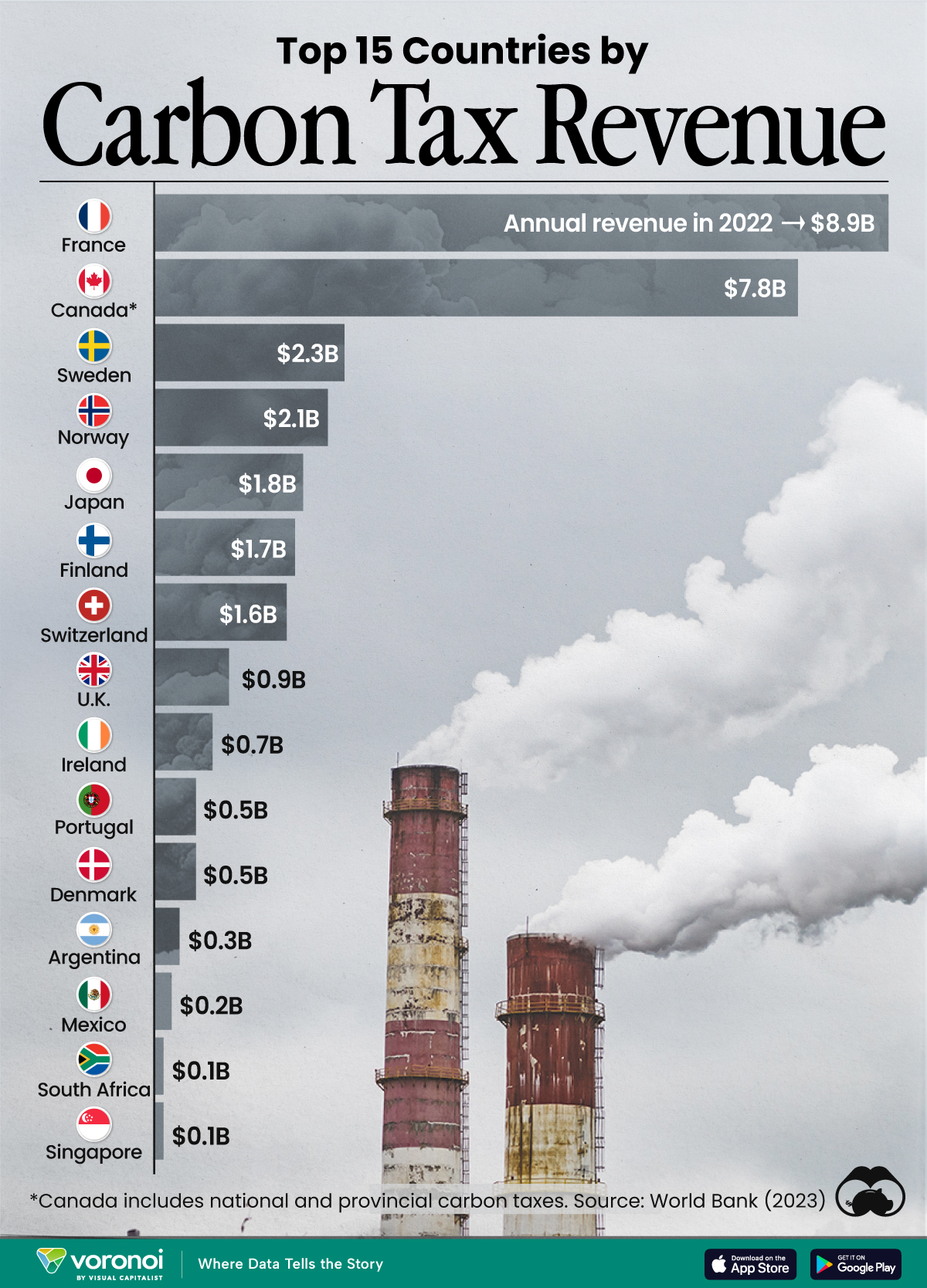Green
Visualizing the Climate Targets of Fortune 500 Companies
View the full-resolution version of this infographic
Visualized: The Climate Targets of Fortune 500 Companies
View the high-resolution version of this infographic by clicking here
The Fortune Global 500 is a ranking of the world’s 500 largest companies by revenue. In 2019, this influential group employed 70 million people and generated revenues of over $33 trillion.
Given their size and influence, many of these companies are taking climate action quite seriously. For example, 30% of the group have either achieved a climate goal or are publicly committed to doing so by 2030—a significant increase from just 6% in 2016.
In this infographic, we’ve used data from Natural Capital Partners to provide a holistic view of when Fortune Global 500 companies plan to meet their stated climate goals.
Climate Action Takes Several Forms
When taking climate action, businesses have a variety of targets they can pursue. Three of the most common ones include carbon neutrality, RE100, and science based targets (SBT).
| Climate target type | Description |
|---|---|
| Carbon neutral | Achieved when a company completely offsets its greenhouse gas (GHG) emissions. |
| RE100 | Achieved when a company relies on 100% renewable energy. |
| Science based targets (SBT) | Emissions are reduced in line with the need to keep global warming below 2ºC. |
After choosing a target, businesses can also set a date for when they intend to achieve it. As the above graphic shows, many companies are targeting 2030, a year that is frequently touted as a deadline for meeting the goals of the Paris Agreement.
A fourth target known as “net zero emissions” is also used, though its exact definition tends to vary. For the purposes of this infographic, we’ve considered a commitment to net zero emissions to be the same as achieving carbon neutrality.
A Complete Overview
The following table summarizes the climate actions of Fortune Global 500 companies. Firms that made commitments without a target date have been noted in the table with a “C”.
| Company Name | Headquarters | Carbon Neutral (target date) | RE100 (target date) | SBT (target date) |
|---|---|---|---|---|
| Commonwealth Bank of Australia | 🇦🇺Australia | 2030 | ||
| Westpac Banking | 🇦🇺Australia | 2013 | 2025 | |
| Woolworths Group | 🇦🇺Australia | C | ||
| Anheuser-Busch InBev | 🇧🇪Belgium | 2025 | 2025 | |
| Banco Bradesco | 🇧🇷Brazil | 2019 | ||
| Banco do Brasil | 🇧🇷Brazil | 2019 | ||
| Caixa Econômica Federal | 🇧🇷Brazil | 2018 | ||
| Vale | 🇧🇷Brazil | 2050 | ||
| Bank of Montreal | 🇨🇦Canada | 2010 | ||
| Royal Bank of Canada | 🇨🇦Canada | 2017 | ||
| Toronto-Dominion Bank | 🇨🇦Canada | 2010 | ||
| Lenovo Group | 🇨🇳China | 2030 | ||
| Xiamen ITG Holding Group | 🇨🇳China | C | ||
| Maersk Group | 🇩🇰Denmark | 2050 | ||
| Nokia | 🇫🇮Finland | 2030 | ||
| Auchan Holding | 🇫🇷France | |||
| AXA | 🇫🇷France | 2025 | ||
| BNP Paribas | 🇫🇷France | 2017 | ||
| Carrefour | 🇫🇷France | 2030 | ||
| CMA CGM | 🇫🇷France | 2050 | ||
| Crédit Agricole | 🇫🇷France | C | ||
| Danone | 🇫🇷France | 2050 | 2030 | 2030 |
| Electricité de France | 🇫🇷France | 2050 | ||
| Engie | 🇫🇷France | 2030 | ||
| L'Oréal | 🇫🇷France | 2020 | 2027 | |
| La Poste | 🇫🇷France | 2012 | 2020 | 2025 |
| Michelin | 🇫🇷France | 2030 | ||
| Orange | 🇫🇷France | 2040 | ||
| Renault | 🇫🇷France | 2030 | ||
| Saint-Gobain | 🇫🇷France | 2025 | ||
| Sanofi | 🇫🇷France | 2030 | ||
| Schneider Electric | 🇫🇷France | 2025 | 2030 | 2030 |
| Siemens | 🇫🇷France | 2030 | ||
| Société Générale | 🇫🇷France | C | ||
| Veolia Environnement | 🇫🇷France | 2034 | ||
| Vinci | 🇫🇷France | 2050 | ||
| Adidas | 🇩🇪Germany | 2050 | ||
| Allianz | 🇩🇪Germany | 2012 | 2023 | |
| Bayer | 🇩🇪Germany | 2030 | ||
| BMW Group | 🇩🇪Germany | 2050 | ||
| Bosch Group | 🇩🇪Germany | 2020 | ||
| Continental | 🇩🇪Germany | 2040 | 2030 | |
| Daimler | 🇩🇪Germany | 2039 | ||
| Deutsche Bahn | 🇩🇪Germany | 2050 | 2030 | |
| Deutsche Bank | 🇩🇪Germany | 2013 | ||
| Deutsche Post DHL Group | 🇩🇪Germany | 2050 | ||
| Deutsche Telekom | 🇩🇪Germany | 2050 | 2021 | 2030 |
| E.ON | 🇩🇪Germany | 2040 | ||
| Metro | 🇩🇪Germany | 2030 | ||
| Munich Re Group | 🇩🇪Germany | 2015 | ||
| SAP | 🇩🇪Germany | 2025 | 2014 | 2025 |
| ThyssenKrupp | 🇩🇪Germany | 2030 | ||
| Uniper | 🇩🇪Germany | 2035 | ||
| Volkswagen | 🇩🇪Germany | 2050 | ||
| ZF Friedrichshafen | 🇩🇪Germany | 2040 | ||
| State Bank of India | 🇮🇳India | 2030 | ||
| Tata Motors | 🇮🇳India | 2030 | ||
| Accenture | 🇮🇪Ireland | 2023 | 2025 | |
| CRH | 🇮🇪Ireland | 2050 | ||
| Johnson Controls International | 🇮🇪Ireland | C | ||
| Enel | 🇮🇹Italy | 2050 | 2030 | |
| ENI | 🇮🇹Italy | 2030 | ||
| AEON | 🇯🇵Japan | 2050 | 2030 | 2027 |
| Dai-ichi Life Holdings | 🇯🇵Japan | 2050 | ||
| Daiwa House Industry | 🇯🇵Japan | 2040 | 2030 | |
| Fujitsu | 🇯🇵Japan | 2050 | 2030 | |
| Hitachi | 🇯🇵Japan | C | ||
| Mitsubishi Electric | 🇯🇵Japan | 2030 | ||
| NEC | 🇯🇵Japan | 2050 | 2030 | |
| Nissan Motor | 🇯🇵Japan | 2050 | ||
| Panasonic | 🇯🇵Japan | 2050 | 2030 | |
| Sompo Holdings | 🇯🇵Japan | C | ||
| Sony | 🇯🇵Japan | 2040 | 2020 | |
| Sumitomo Electric Industries | 🇯🇵Japan | 2050 | ||
| Takeda Pharmaceutical | 🇯🇵Japan | 2019 | 2025 | |
| Tokio Marine Holdings | 🇯🇵Japan | 2011 | ||
| Toshiba | 🇯🇵Japan | |||
| Toyota Motor | 🇯🇵Japan | 2050 | ||
| América Móvil | 🇲🇽Mexico | 2050 | ||
| Achmea | 🇳🇱Netherlands | 2011 | ||
| Aegon | 🇳🇱Netherlands | 2016 | ||
| Heineken Holding | 🇳🇱Netherlands | C | ||
| ING Group | 🇳🇱Netherlands | 2007 | 2020 | |
| Equinor | 🇳🇴Norway | 2030 | ||
| Anglo American | 🇿🇦South Africa | 2040 | ||
| Hyundai Motor | 🇰🇷South Korea | 2050 | ||
| LG Electronics | 🇰🇷South Korea | 2030 | ||
| Banco Bilbao Vizcaya Argentaria | 🇪🇸Spain | 2020 | 2030 | |
| Banco Santander | 🇪🇸Spain | 2020 | ||
| Iberdrola | 🇪🇸Spain | 2050 | 2030 | |
| Inditex | 🇪🇸Spain | C | ||
| Mapfre Group | 🇪🇸Spain | 2030 | ||
| Naturgy Energy Group | 🇪🇸Spain | C | ||
| Telefónica | 🇪🇸Spain | 2030 | 2030 | 2025 |
| Volvo | 🇸🇪Sweden | 2025 | ||
| ABB | 🇨🇭Switzerland | 2018 | ||
| Adecco Group | 🇨🇭Switzerland | 2030 | ||
| Coop Group | 🇨🇭Switzerland | 2023 | ||
| Credit Suisse Group | 🇨🇭Switzerland | 2010 | 2025 | |
| LafargeHolcim | 🇨🇭Switzerland | 2030 | ||
| Migros Group | 🇨🇭Switzerland | C | ||
| Nestlé | 🇨🇭Switzerland | 2020 | ||
| Novartis | 🇨🇭Switzerland | 2025 | 2030 | |
| Swiss Re | 🇨🇭Switzerland | 2003 | 2020 | |
| Zurich Insurance Group | 🇨🇭Switzerland | 2014 | 2022 | |
| Fubon Financial Holding | 🇹🇼Taiwan | C | ||
| PTT | 🇹🇭Thailand | C | ||
| Aviva | 🇬🇧UK | 2006 | 2025 | |
| Barclays | 🇬🇧UK | 2030 | ||
| British American Tobacco | 🇬🇧UK | 2030 | 2028 | |
| BT Group | 🇬🇧UK | 2020 | 2030 | |
| Compass Group | 🇬🇧UK | C | ||
| GlaxoSmithKline | 🇬🇧UK | 2050 | 2027 | |
| HSBC Holdings | 🇬🇧UK | 2030 | ||
| J. Sainsbury | 🇬🇧UK | 2040 | ||
| Linde | 🇬🇧UK | C | ||
| Phoenix Group Holdings | 🇬🇧UK | 2030 | ||
| Tesco | 🇬🇧UK | 2050 | 2030 | 2027 |
| Unilever | 🇬🇧UK | 2020 | 2030 | |
| Vodafone Group | 🇬🇧UK | 2025 | ||
| 3M | 🇺🇸USA | 2050 | ||
| Alphabet | 🇺🇸USA | 2007 | 2017 | |
| Amazon.com | 🇺🇸USA | 2040 | 2025 | 2040 |
| American Express | 🇺🇸USA | 2018 | ||
| Anthem | 🇺🇸USA | 2025 | ||
| Apple | 🇺🇸USA | 2020 | 2020 | |
| AT&T | 🇺🇸USA | 2028 | ||
| Bank of America | 🇺🇸USA | 2020 | 2020 | |
| Best Buy | 🇺🇸USA | 2050 | 2030 | |
| Capital One Financial | 🇺🇸USA | 2018 | 2019 | |
| Cisco Systems | 🇺🇸USA | 2022 | ||
| Citigroup | 🇺🇸USA | 2020 | ||
| Coca-Cola | 🇺🇸USA | 2030 | ||
| CVS Health | 🇺🇸USA | 2028 | ||
| Dell Technologies | 🇺🇸USA | 2040 | 2020 | |
| Delta Air Lines | 🇺🇸USA | 2020 | ||
| Dow | 🇺🇸USA | 2050 | ||
| 🇺🇸USA | 2020 | |||
| Ford Motor | 🇺🇸USA | 2050 | ||
| General Motors | 🇺🇸USA | 2050 | ||
| Goldman Sachs Group | 🇺🇸USA | 2015 | 2020 | |
| Hewlett Packard Enterprise | 🇺🇸USA | 2025 | ||
| HP | 🇺🇸USA | 2035 | 2025 | |
| Intel | 🇺🇸USA | 2030 | ||
| Johnson & Johnson | 🇺🇸USA | 2050 | ||
| JPMorgan Chase | 🇺🇸USA | 2020 | ||
| Lowe's | 🇺🇸USA | 2025 | ||
| MetLife | 🇺🇸USA | 2016 | ||
| Microsoft | 🇺🇸USA | 2012 | 2017 | 2030 |
| Mondelez International | 🇺🇸USA | 2025 | ||
| Morgan Stanley | 🇺🇸USA | 2022 | 2022 | |
| Nike | 🇺🇸USA | 2025 | 2030 | |
| PepsiCo | 🇺🇸USA | 2030 | ||
| Pfizer | 🇺🇸USA | 2020 | ||
| Philip Morris International | 🇺🇸USA | 2050 | 2030 | |
| Procter & Gamble | 🇺🇸USA | 2030 | 2030 | 2030 |
| Schlumberger | 🇺🇸USA | C | ||
| Starbucks | 🇺🇸USA | 2020 | ||
| Target | 🇺🇸USA | 2030 | 2028 | |
| Tyson Foods | 🇺🇸USA | 2030 | ||
| Verizon Communications | 🇺🇸USA | 2035 | ||
| Walmart | 🇺🇸USA | 2025 | 2027 | |
| Wells Fargo | 🇺🇸USA | 2019 | 2020 |
Note: This data was aggregated from various sources throughout 2020, and as a result, may not include the latest climate commitments announced by companies within the Fortune Global 500.
As of October 2020, 163 companies from the Fortune Global 500 have publicly committed to achieving at least one of these climate targets. That represents 32.6% of the total group.
The most common target is carbon neutrality, which has 91 companies on board. In second place is science based targets (SBT), which has 74 companies committed—of those, 16 have not declared a target date. RE100 was the least common, with 56 companies committed. Because some companies are committed to multiple targets, these figures add to more than 163.
Climate Action is on the Rise
Private-sector awareness around climate change and other sustainability issues has gained strong momentum in recent years.
Since 2011, the number of S&P 500 companies publishing sustainability reports increased from 20% in 2011, to 90% in 2019. This was likely due to investor demand and a broader acceptance of environmental, social, and governance (ESG) criteria.
Governments around the world are also taking a more proactive approach to climate action. The Biden administration, for example, seeks to make a $2 trillion investment to help a variety of U.S. industries become more sustainable.
“We have the opportunity to build a more resilient, sustainable economy – one that will put the United States on an irreversible path to achieve net-zero emissions…by no later than 2050.”
– Biden-Harris campaign
America’s goal of reaching net-zero emissions by 2050 is shared with a handful of other advanced economies, including Japan and the EU. The UK has taken these pledges one step further, becoming the first G7 country to pass a law that requires itself to bring emissions to net zero by 2050.
Green
Ranking the Top 15 Countries by Carbon Tax Revenue
This graphic highlights France and Canada as the global leaders when it comes to generating carbon tax revenue.
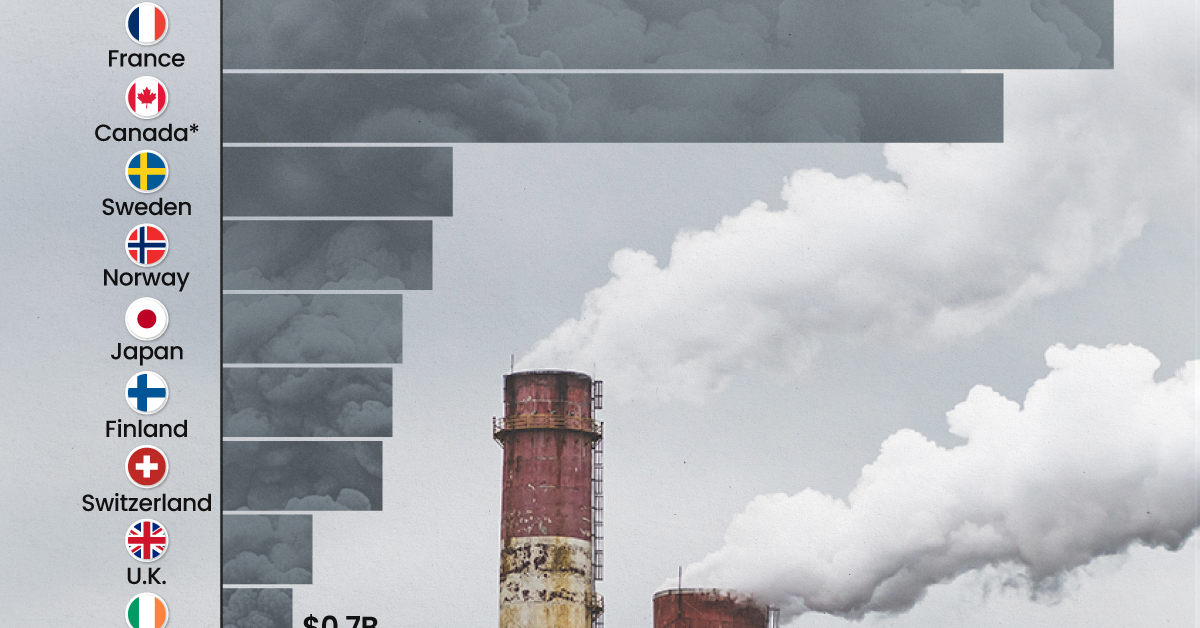
Top 15 Countries by Carbon Tax Revenue
This was originally posted on our Voronoi app. Download the app for free on iOS or Android and discover incredible data-driven charts from a variety of trusted sources.
Carbon taxes are designed to discourage CO2 emissions by increasing the cost of carbon-intensive activities and incentivizing the adoption of cleaner energy alternatives.
In this graphic we list the top 15 countries by carbon tax revenue as of 2022. The data is from the World Bank’s State and Trends of Carbon Pricing Report, published in April 2023.
France and Canada Lead in Global Carbon Tax Revenue
In 2022, the top 15 countries generated approximately $30 billion in revenue from carbon taxes.
France and Canada lead in this regard, accounting for over half of the total amount. Both countries have implemented comprehensive carbon pricing systems that cover a wide range of sectors, including transportation and industry, and they have set relatively high carbon tax rates.
| Country | Government revenue in 2022 ($ billions) |
|---|---|
| 🇫🇷 France | $8.9 |
| 🇨🇦 Canada | $7.8 |
| 🇸🇪 Sweden | $2.3 |
| 🇳🇴 Norway | $2.1 |
| 🇯🇵 Japan | $1.8 |
| 🇫🇮 Finland | $1.7 |
| 🇨🇭 Switzerland | $1.6 |
| 🇬🇧 United Kingdom | $0.9 |
| 🇮🇪 Ireland | $0.7 |
| 🇩🇰 Denmark | $0.5 |
| 🇵🇹 Portugal | $0.5 |
| 🇦🇷 Argentina | $0.3 |
| 🇲🇽 Mexico | $0.2 |
| 🇸🇬 Singapore | $0.1 |
| 🇿🇦 South Africa | $0.1 |
In Canada, the total carbon tax revenue includes both national and provincial taxes.
While carbon pricing has been recognized internationally as one of the more efficient mechanisms for reducing CO2 emissions, research is divided over what the global average carbon price should be to achieve the goals of the Paris Climate Agreement, which aims to limit global warming to 1.5–2°C by 2100 relative to pre-industrial levels.
A recent study has shown that carbon pricing must be supported by other policy measures and innovations. According to a report from Queen’s University, there is no feasible carbon pricing scenario that is high enough to limit emissions sufficiently to achieve anything below 2.4°C warming on its own.
-

 Technology2 weeks ago
Technology2 weeks agoRanked: The Most Popular Smartphone Brands in the U.S.
-

 Automotive1 week ago
Automotive1 week agoAlmost Every EV Stock is Down After Q1 2024
-

 Money1 week ago
Money1 week agoWhere Does One U.S. Tax Dollar Go?
-

 Green2 weeks ago
Green2 weeks agoRanked: Top Countries by Total Forest Loss Since 2001
-

 Real Estate2 weeks ago
Real Estate2 weeks agoVisualizing America’s Shortage of Affordable Homes
-

 Maps2 weeks ago
Maps2 weeks agoMapped: Average Wages Across Europe
-

 Mining2 weeks ago
Mining2 weeks agoCharted: The Value Gap Between the Gold Price and Gold Miners
-

 Demographics2 weeks ago
Demographics2 weeks agoVisualizing the Size of the Global Senior Population

